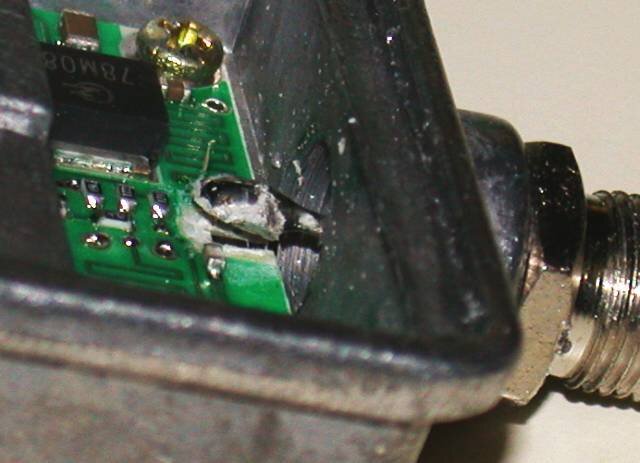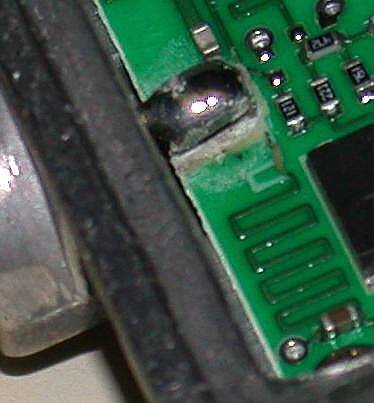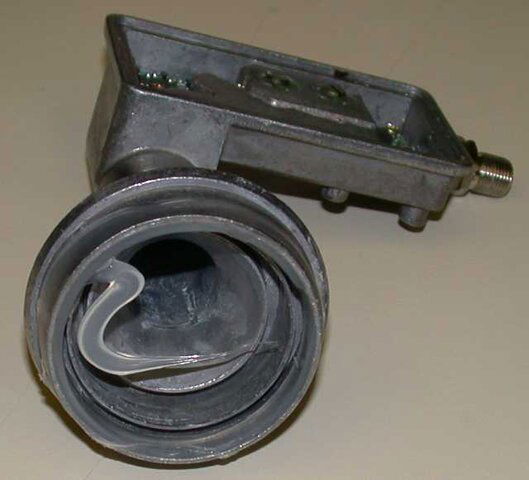Well, today I learned the hard way why we don't torque the bejesus out of our F connectors with wrenches and the like. I had used a wrench to gently tighten a cable onto my LNB. Well, today I wanted to remove that connection and couldn't do it with my fingers, so I got my trusty Leatherman tool and proceeded to twist - the wrong direction.  Before I knew it, the nut at the top of the connector, the one that's on the LNB itself, started turning and I knew I'd hosed it. Sure enough, I hooked it back up and got nothing at all. I did, however, take my LNB apart and take a few pictures.
Before I knew it, the nut at the top of the connector, the one that's on the LNB itself, started turning and I knew I'd hosed it. Sure enough, I hooked it back up and got nothing at all. I did, however, take my LNB apart and take a few pictures.
In the first picture you can see that I've managed to tear the solder pad right off the circuit board altogether. I must have twisted the thing 360 degrees before I noticed what I'd done. What looks like a scratch on the stripline traces in the background is actually a circuit board trace sticking out of that big solder blob straight up into the air.
The second picture gives another view of the situation. Look closely and you can see that I've torn some of the stripline circuitry right off. I'm pretty handy with a soldering iron and ordinarily I'd just try to repair this, but that torn stripline makes me think I shouldn't even bother. Everything's so damned critical at these frequencies. It might work or it might not - at least this is damaged at the low-frequency end of the signal path, so I might stand a chance.
The final picture is what I saw when I pulled the cap off the feedhorn. This is a "Besat" 0.3 dB LNB - the cheap ones you can find for next to nothing on eBay. It seemed to work well enough, but I can't help wonder if that huge glob of silicone sealant wasn't absorbing some signal. Maybe silicone is transparent at 12 GHz, but regardless, this is certainly a sign of shoddy manufacturing. Still, I knew what I was getting into when I bought it. I just wanted a cheap LNB to get started in FTA.
So now I'm stuck with an old DirecTV LNB on my dish, picking up a bunch of free radio stations and some ExpressVu barker channels on Nimiq 1/3. My girlfriend's Canadian and is visiting for the holidays so I figured I'd give her some Canadian radio to make her feel at home. Heh... There really isn't jack out there as far as FTA when you're stuck with a circular-polarization LNB.
I guess it's time to order that quad Invacom I've been eyeing...
In the first picture you can see that I've managed to tear the solder pad right off the circuit board altogether. I must have twisted the thing 360 degrees before I noticed what I'd done. What looks like a scratch on the stripline traces in the background is actually a circuit board trace sticking out of that big solder blob straight up into the air.
The second picture gives another view of the situation. Look closely and you can see that I've torn some of the stripline circuitry right off. I'm pretty handy with a soldering iron and ordinarily I'd just try to repair this, but that torn stripline makes me think I shouldn't even bother. Everything's so damned critical at these frequencies. It might work or it might not - at least this is damaged at the low-frequency end of the signal path, so I might stand a chance.
The final picture is what I saw when I pulled the cap off the feedhorn. This is a "Besat" 0.3 dB LNB - the cheap ones you can find for next to nothing on eBay. It seemed to work well enough, but I can't help wonder if that huge glob of silicone sealant wasn't absorbing some signal. Maybe silicone is transparent at 12 GHz, but regardless, this is certainly a sign of shoddy manufacturing. Still, I knew what I was getting into when I bought it. I just wanted a cheap LNB to get started in FTA.
So now I'm stuck with an old DirecTV LNB on my dish, picking up a bunch of free radio stations and some ExpressVu barker channels on Nimiq 1/3. My girlfriend's Canadian and is visiting for the holidays so I figured I'd give her some Canadian radio to make her feel at home. Heh... There really isn't jack out there as far as FTA when you're stuck with a circular-polarization LNB.
I guess it's time to order that quad Invacom I've been eyeing...




